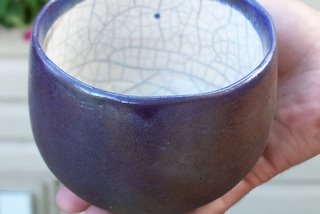
This Teabowl was made from a heavily grogged white stoneware clay body and bisque fired to approximately 1600 degrees.
Once bisqued the bowl was placed on a banding wheel and a coating of liquid wax was applied to the exterior. This was done so a neat glaze line at the rim could be easily achieved. The interior and rim were then glazed with Ferguson's Turquoise Raku Glaze.
The teabowl was then fired in a fiber-lined raku kiln until glowing hot and the glaze was liquid-glassy, approximately 1900 degrees.
At this time the teabowl was removed from the kiln and individual strands of horsehair were applied to the exterior of the surface. The hair imediately begins to burn and shrivels up resulting in a small deposit of smoke and carbon, leaving a permanent trace of the horsehair.
The ashes are washed off once the piece is cool and when the bowl is completely dry the exterior is polished with paste wax and buffed to a soft satin luster finish.


